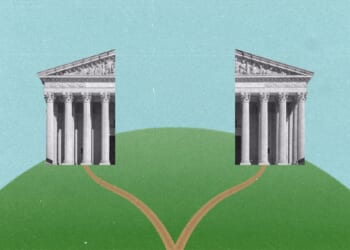One of the basic tenets of religious scholarship is that religions reflect the society that created them. In Protestant Ethic and the Spirit of Capitalism, the German social theorist Max Weber tried to explain why modern capitalism emerged in 17th-century Europe and not somewhere else. His answer was that the economic system that now dominates the world grew out of a specific religious ethic. The Calvinists of the day, eager to demonstrate that they were among those predestined for Heaven, worked hard and lived frugally. These virtues became the cultural soil in which capitalism could flourish.
Take Weber’s idea to its conclusion and Donald Trump, Elon Musk and Jeff Bezos could be conceived of as the spiritual heirs to Martin Luther. Which raises the question: if Luther begat capitalism, what kind of faith does capitalism itself beget?
It might look something like Human Design: an arcane New Age belief system invented by a Canadian music promoter named Alan Robert Krakower after an eight-day visitation from a “Voice” in Ibiza in 1987. Krakower then created a gospel of self-knowledge — a deliberately arcane blend of life coaching and woo-infused mysticism — that spread far beyond him. Though Krakower renamed himself Ra Uru Hu in 2011, his gospel is currently being preached not only on social media, where some of its preachers, such as the popular Amanda Horvath, have tens or hundreds of thousands of followers, but on TV. In July, a Human Design coach, appearing in the show Love is Blind, explained that his mantra in life, as per his training, was to “trust your spleen”. Most interestingly, Human Design has penetrated business retreats, leadership conferences, and that most corporate of temples: LinkedIn.
One apostle, Joshua B. Lee, a forty-something Texan online marketer who styles himself the “Dopamine Dealer of LinkedIn”, recently posted about how Human Design led him to achieve millions of “organic views” on the platform. Not for him the grind of search-engine analytics, audience study or content scheduling. Human Design allowed him instead to tap into a higher power: his “true self.”
Lee’s post, written in August, has attracted glowing responses from many CEOs and founders. “Sometimes the real growth strategy is trusting yourself over the trends” writes one. “When you’re misaligned, every opportunity feels like a struggle to fit in”, adds another.
Thanks to apostles such as Lee, Human Design is acquiring growing influence on the business networking platform. Once consigned to the fringes of New Age spirituality, it has marched into the language of C-suite executives and start-up hustlers, fusing with more conventional life and career coaching. Though it might be tempting to write it off with an eye roll — Astrology in a suit! — its popularity among business leaders suggests something more telling: that the cult of optimisation is now open to almost any framework, no matter how baroque.
Synthesising several ancient and modern elements into a way of analysing the self, Human Design combines elements of mysticism, life coaching and the sort of quasi-culty, pseudo-scientific theorising that any one of us might come up with after eight days in Ibiza with the help of some hallucinogens. “I often ponder the great neutrino ocean because the neutrino ocean is the consciousness field,” writes Ra in one of his foundational texts. It borrows freely from astrology, the I Ching, the Kabbalah and the Hindu chakra system, then wraps it in the language of quantum physics and genetics.
But at its heart is the BodyGraph, a chart said to be as individual as a fingerprint, generated from the date, time and place of your birth. In this respect it is akin to astrology. Unlike astrology, however, Human Design is based not only on your birth moment — even a few minutes’ difference can alter the chart — but also on the precise timing of another moment, roughly 88 days earlier, which is said to capture your unconscious “design”. These two data points are then mapped onto a hybrid cosmology that fuses astrology with the I Ching, a few other belief systems and a dash of quantum physics.
One of the main reasons it has caught on is that the charts are easy to generate. Simply plug your birth details into any Human Design website and you’ll receive a diagram of a body that features nine “centres,” 64 “gates” and 36 “channels,” coloured in or left blank depending on which planetary influences were active when you arrived on earth.
I tried it myself and was duly told which “Type” I am: a “Manifesting generator”, since you ask. According to the horoscopic patois of Human Design, that means I’m “efficient, multi-passionate, and thrive on a variety of projects.” The chart then offered me a baffling tangle of triangles, squares and numbers, inscrutable without an interpreter.
The promise of hidden knowledge was there, but locked away in the chart. The chart itself was part wiring diagram, part horoscope, requiring a guide to decode. As in the Catholic church that Martin Luther rebelled against, the reliance on experts is, of course, part of the business model.
In many ways, Human Design is simply the latest iteration of a much longer Western obsession: classifying the self. In the post-God, post-feminism, post-race era of the 1990s, when globalisation — with all the religious and cultural flattening it implied — seemed inevitable, a generation of Western teens and pre-teens were being primed to receive the message that there is no higher calling than the project of the self. Self-love, self-care, self-improvement. To understand and optimise the self was the ultimate goal.
I grew up in that era. Even as a pre-teen, I found myself filling out sex quizzes in Mizz magazine: answer some multiple-choice questions and you find out which of four or so categories you fall into. This habit developed into affinity for astrology, which offered both entertainment and a sense of identity in the absence of formal belief systems. Astrology, in keeping with the times, has expanded from newspaper horoscopes to broader psychological profiling: you are an Aquarius, and this is why you’re so free; she’s a Gemini, no wonder she’s messed up, and so on. We all love reading about ourselves.
Human Design, however, is rather more dogmatic in its conclusions. It claims to supersede anything as silly and fallible as personal choice. One Master Coach, with a book and a podcast to prove it, tells me that personality profiling tools like the Myers Briggs test are unreliable because they are based on questionnaires; and questionnaires are unreliable because, when we fill them out, we carry our own preconceptions and biases. “With Human Design, it’s our energetic profile… an energetic blueprint that we’re born with. Our Human Design will influence our personality, it’ll influence our behaviour, it’s ground zero.”
In other words, a personality test can only ever be provisional: it might wobble depending on our mood or level of honesty. But Human Design, in this view, represents the fundamental truth: so fundamental that it is inscribed even at the subatomic level of physics. According to Human Design lore, neutrinos — near-massless particles that are produced by stars and pass through humans and other matter constantly — carry imprinted information that conditions us at birth. To believers, neutrinos are the medium through which the cosmos stamps its data into the chart. To sceptics, the neutrino theory is an audacious borrowing of scientific language; a way of making astrology charts sound like they’re written by CERN scientists.
“Human Design, in this view, represents the fundamental truth: so fundamental that it is inscribed even at the subatomic level of physics.”
As I found, interpreting the BodyGraph is formidably complex. At the entry level you can buy ebooks or online courses, the kind that promise to help you decode your own chart, for a few hundred pounds. But to become an accredited reader or analyst is far more expensive. Certification runs into the thousands, with full professional training typically costing $3,000–$5,000, and advanced mentoring packages stretching well into five figures. It is a kind of multi-level marketing scheme where every new believer is a potential customer and every customer is encouraged to become a seller. To its critics, it looks an awful lot like a pyramid scheme.
In practice, most people outsource their self-analysis to a coach who translates the circuitry into digestible personality shorthand. Each person is placed into one of five overarching Types — Manifestor, Generator, Manifesting Generator (that’s me), Projector or Reflector — but how that plays out is coloured by a dense layering of “profiles,” “authorities,” “centres,” “gates” and “channels.” You might discover that your “undefined centres” make you more likely to be affected by the moods of others, or that your “strategy” is to wait for the right invitation before acting.
Behind the jargon lies the simple creed that your individuality, and its allocated blueprint, supersede any other authority. On Reddit, I found accounts of people freezing out well-meaning parents because of incompatible Human Designs, or dumping their friends in response to Human Design encouragement to “guard” their energies. Another Reddit user reported having followed the dictum by eating whatever they wanted — then gained more than a stone. When I reached out to the Reddit user in the hope of asking them some questions, they explained that they would “follow up with you in a few days as it is my sacral [basically ‘the gut’] that makes my decisions.” I didn’t hear from them again.
The Master Coach I spoke to told me they were preparing to run a retreat in Ohio for 16 American startup founders, focusing on how they can scale their businesses based on their Human Designs. “I think the reason why it’s taking off so quickly now,” they say, “is because people are finally getting their answers. [Human Design] is finally giving them permission to be themselves.”
Modern CEOs and founders are faced with a thicket of impossible variables. There’s market volatility; there’s an unpredictable geopolitical landscape; and algorithms that can change overnight with no warning. No one can quite explain why TikTok suddenly throttled their views, or why Meta’s ad targeting stopped working for them. In this context, Human Design promises a roadmap to smarter, more “authentic” decisions — decisions that are intrinsically right because you made them.
At its core, Human Design is a gospel of individualism. Your chart is yours alone; your “authority”, to use the jargon, overrides every external signal. The system does not ask for compromise or collective responsibility; it insists that flourishing comes from understanding yourself. In that sense it is less a shared cosmology than a cult of the self: a message that naturally resonates with some of the capitalists of LinkedIn, where instinct, vision and “authentic leadership” are already treated as sacrosanct virtues.
The potential for narcissistic misuse, abuse, exploitation, financial or otherwise, is only heightened by the system’s plasticity. Some former devotees warn of Human Design’s cult-like tendencies. One of them writes that Ra’s charisma ensured that his word, even after death, was treated as law by disciples who became absolutists. Those who leave Human Design are shamed, warned the whistleblower.
On the surface, Human Design insists that you are utterly unique, that no one can tell you how to live but your inner Authority. Yet in practice, the community can feel strangely uniform: everyone reciting the same jargon, revering the same founder, and buying into the same training structures. It even has its own doomsday prophecy: in Human Design lore, 2027 is the year the world tips over, when governments and families will unravel, a new wave of telepathic “Rave children” will appear, and only those living their “design” will thrive.
In the end, Human Design may be less about cosmic circuitry than about the hunger for certainty in a world of impossible variables. As one of the coaches told me: “Humans are storytellers and we want to make meaning of everything. If you look at the past 100 years, there’s been constant upheaval. And many people have come out of that thinking, who am I? What am I doing? What’s my role on the planet?”
And in that sense, Joshua B. Lee’s LinkedIn feed tells us everything we need to know: even the stars can be harnessed as a decision-making framework, as long as they promise growth.

















